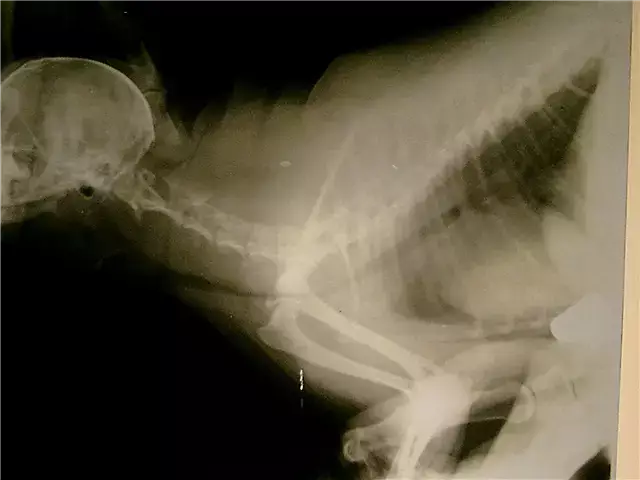- Author Rachel Wainwright [email protected].
- Public 2023-12-15 07:39.
- Last modified 2025-11-02 20:14.
Jardins
Instructions for use:
- 1. Release form and composition
- 2. Indications for use
- 3. Contraindications
- 4. Method of application and dosage
- 5. Side effects
- 6. Special instructions
- 7. Drug interactions
- 8. Analogs
- 9. Terms and conditions of storage
- 10. Terms of dispensing from pharmacies
Prices in online pharmacies:
from 2610 rub.
Buy

Jardins is a hypoglycemic agent, inhibitor of type II sodium-dependent glucose transporter.
Release form and composition
Jardins is available in the following dosage forms:
- film-coated tablets, 10 mg: biconvex, round, beveled, with a light yellow shell, engraved on both sides (on one side - the company symbol, on the other - "S10");
- film-coated tablets, 25 mg: biconvex, oval, beveled, with a light yellow shell, engraved on both sides (on one side - the company symbol, on the other - "S25").
The drug is packed in PVC / Al blisters (10 tablets in a blister, one or three blisters together with instructions for use in a cardboard box).
1 tablet contains:
- active substance: empagliflozin - 10/25 mg;
- auxiliary components: lactose monohydrate - 162.5 / 113 mg, microcrystalline cellulose - 62.5 / 50 mg, hyprolose (hydroxypropyl cellulose) - 7.5 / 6 mg, croscarmellose sodium - 5/4 mg, colloidal silicon dioxide - 1.25 / 1 mg, magnesium stearate - 1.25 / 1 mg;
- shell: yellow opadry (02B38190) - 7/6 mg (hypromellose 2910 - 3.5 / 3 mg, talc - 1.4 / 1.2 mg, titanium dioxide - 1.733 / 1.485 mg, iron dye yellow oxide - 0.018 / 0.015 mg, macrogol 400 - 0.35 / 0.3 mg).
Indications for use
Diabetes mellitus type II.
Jardins is also used:
- in the case of uncontrolled glycemia only against the background of exercise and diet, as well as with intolerance to metformin - in the form of monotherapy;
- in the case when the applied therapy does not provide the necessary glycemic control - in the form of complex therapy with other hypoglycemic agents (including insulin).
Contraindications
- hypersensitivity to drug components;
- rare hereditary disorders (lactose intolerance, lactase deficiency, glucose-galactose malabsorption);
- diabetic ketoacidosis;
- type I diabetes mellitus;
- renal failure with persistent GFR <45 ml / min per 1.73 m 2;
- pregnancy and lactation;
- combined use with analogs of glucagon-like peptide 1 (GLP-1);
- age up to 18 years old and from 85 years old.
Diseases / conditions for which Jardins is used with caution (relative contraindications):
- low carb diet;
- a history of diabetic ketoacidosis;
- low secretory activity of beta cells of the pancreas;
- infections of the genitourinary system;
- combined use with insulin or sulfonylurea derivatives;
- diseases of the gastrointestinal tract associated with fluid loss;
- age from 75 to 85 years.
In addition, the drug is used with caution in patients at risk of developing hypovolemia (consumption of antihypertensive drugs with a history of arterial hypotension).
Method of administration and dosage
The starting dose is 10 mg (1 10 mg tablet) orally, once a day.
If the daily dose of 10 mg does not provide sufficient glycemic control, then the dose should be increased to 25 mg (1 tablet with a dosage of 25 mg) orally, once a day.
The maximum daily dose is 25 mg.
The use of Jardins is possible at any time of the day, regardless of food intake.
In the event that the patient missed taking the drug, then the treatment should be resumed as soon as he remembers about it.
It is not recommended to take a double dose on the same day.
Side effects
- parasitic and infectious diseases: urinary tract infections, vulvovaginitis, balanitis, vaginal candidiasis and other genital infections;
- metabolism and nutrition: hypoglycemia (when combined with insulin and sulfonylurea derivatives);
- skin and subcutaneous tissue: itching;
- vessels: hypovolemia;
- kidneys and urinary tract: dysuria, frequent urination.
special instructions
Jardins should not be used in patients with type I diabetes or for the treatment of diabetic ketoacidosis.
If symptoms such as nausea, vomiting, abdominal pain, lack of appetite, severe thirst, disorientation, difficulty breathing, rapid fatigue or drowsiness appear, consider the possibility of developing diabetic ketoacidosis. In the event that such symptoms are observed, an immediate examination for ketoacidosis is required, regardless of the concentration of glucose in the blood, and the use of the drug should be discontinued or temporarily suspended until a diagnosis is made.
Clinical studies have shown that treatment with empagliflozin does not increase cardiovascular risk. The use of empagliflozin at a dose of 25 mg does not lead to an increase in the QT interval.
When using Jardins, patients need to be careful when operating machinery and vehicles.
Drug interactions
With the complex use of Jardins with other drugs, the following manifestations of their joint influence are possible:
- thiazide and loop diuretics: increased effect, which in turn increases the risk of arterial hypotension and dehydration;
- insulin and drugs that increase its secretion: increase the risk of hypoglycemia, therefore, their dose should be reduced.
Analogs
There is no information about Jardins' analogues.
Terms and conditions of storage
Store at a temperature not exceeding 25 ° C. Keep out of reach of children.
Shelf life is 3 years.
Terms of dispensing from pharmacies
Dispensed by prescription.
Jardins: prices in online pharmacies
|
Drug name Price Pharmacy |
|
Jardins 10 mg film-coated tablets 30 pcs. 2610 RUB Buy |
|
Jardins 25 mg film-coated tablets 30 pcs. 2670 RUB Buy |
Information about the drug is generalized, provided for informational purposes only and does not replace the official instructions. Self-medication is hazardous to health!






